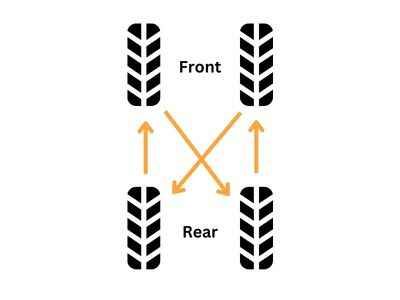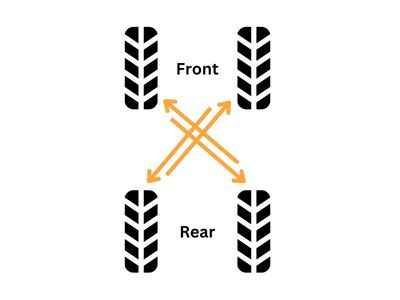Tire rotation is a critical maintenance strategy. It is more than just a routine maintenance task—it’s a crucial strategy for extending the life of your tires, improving vehicle performance, and ensuring your safety on the road. Whether you drive a sedan, SUV, electric vehicle like a Tesla, or a front-wheel-drive car, understanding tire rotation can save you money and prevent potential driving hazards.
What is Tire Rotation?
Tire rotation means changing the position of the tires after a certain period. It ensures the even wear of the tires. If you rotate the tires of your car regularly, you can see the damage visually and can take proper measure to solve the problem. Different driving conditions and vehicle types cause tires to wear differently. That is why regular rotation is essential for maintaining optimal tire performance and longevity.
Why is Tire Rotation Necessary?
There are a number of reasons why tire rotation is important for your car. The reasons are listed below:
1. Extended Tire Life
Consistent tire rotation helps distribute wear evenly across all four tires. By moving tires from one position to another, you prevent premature wear in specific areas, ultimately extending the overall lifespan of your tires.
2. Improved Vehicle Performance
Front-Wheel Drive Vehicles: Maximizing Traction and Control
In front-wheel drive (FWD) vehicles, the front tires bear the brunt of both acceleration and steering responsibilities. These tires experience more stress as they transmit engine power to the road, handle steering inputs and manage braking forces.
Uneven wear in FWD vehicles can lead to reduced cornering ability, increased risk of hydroplaning. The acceleration efficiency of the vehicle is compromised. And potential loss of control happens during sudden maneuvers.
Performance Cars: Precision Engineering Demands Uniform Tire Condition
High-performance vehicles rely on precise tire contact with the road. Even tire wear ensures optimal weight distribution, consistent lateral grip during high-speed cornering. It also ensures maintained suspension geometry, improved acceleration and braking performance.
Electric Vehicles: The Unique Tire Wear Challenge
Tesla and other electric vehicles present unique tire wear considerations:
- Instant torque creates more aggressive tire stress
- Heavier battery weight impacts tire wear patterns
- Regenerative braking adds additional wear to specific tires
- Precise tire condition directly impacts:
- Battery efficiency
- Range optimization
- Handling precision
Advanced Safety Systems: Tire Wear and Vehicle Technology
Modern vehicles equipped with advanced safety technologies depend critically on uniform tire condition:
- Traction control systems require consistent tire performance
- Anti-lock braking (ABS) relies on balanced tire grip
- Electronic stability control needs uniform tire response
- Advanced driver-assistance systems (ADAS) depend on predictable tire behavior
3. Enhanced Safety
Uneven tire wear can lead to reduced grip on the road, increased risk of blowouts, compromised brake performance and potential alignment issues.
Tire Rotation Frequency
The recommended tire rotation frequency varies, but general guidelines include:
- Every 5,000 to 7,500 miles
- During every oil change
- Refer to your vehicle manufacturer’s specific recommendations
Tire Rotation Patterns
Different vehicle types require specific rotation patterns. Specific rotation patterns are required for different type of tires.
If you have tires which are non-directional and of uniform size, then you should use one of the following patterns:
1) Forward Cross Pattern:
This pattern is used for front-wheel drive vehicles. In this pattern, the front tires are installed to the rear on the same side, and the rear tires are sent up and crossed to the opposite side of the front.

2) Rearward Cross Pattern:
This pattern is used for rear-wheel drive vehicles. In this pattern, the rear tires are sent up to the front on the same side. The vehicle’s front tires are sent to the rear. These tires are cross-placed with each other.

3) X Pattern:
Four-wheel vehicles and all-wheel drive vehicles use this pattern of tire rotation. In this pattern, the tire on the front left is installed to the right rear tire’s place, and the tire on the front right is installed to the left rear tire’s place of the vehicle. The tire on the rear left is sent to the front right tire’s place and the tire on the rear right is sent to the front left tire’s place of the vehicle.

If you have tires that are non-directional and of uniform size with a full-size spare tire, then you should use one of the following patterns:
1) Forward Cross Pattern with Spare Tire:
It is used for vehicles with front-wheel drive. Here, the back tires are installed to the front on the opposite side. The spare tire is installed to the right rear tire’s place. The tire on the front left is installed to the left rear tire’s place. Now, the tire on the front right is the spare tire.

2) Rearward Cross Pattern with Spare Tire:
Rear-wheel drive and four-wheel drive vehicles use a rearward cross pattern. In this pattern, the rear tires are installed to the front on the same side. The spare tire is installed to the right rear tire’s place. The tire on the front right is installed to the left rear tire’s place. Now, the tire on the front left is the spare tire.

The following patterns can be used by high-performance and directional tires.
1) Front to Back Pattern:
This pattern is used for directional tires. Here, the front left tire is installed in place of the rear left tire. The front right tire is installed in place of the rear right tire. Doing the opposite, the rear left tire is installed in place of the front left tire, and the rear right tire is installed in place of the front right tire.

2) Side to Side Pattern:
This pattern is used for odd-sized performance tires. In this pattern, the front left tire is installed in place of the front right tire, and the rear left tire is installed in place of the rear right tire. Doing the opposite, the front right tire is installed in place of the front left tire, and the rear right tire is installed in place of the rear left tire.

Due to weight distribution, electric vehicles may have unique rotation requirements. If you have an electric vehicle like Tesla, you should consult manufacturer guidelines for specific recommendations.
Beyond Rotation: Additional Tire Maintenance
Tire Alignment
Tire alignment, often called wheel alignment, is a critical automotive maintenance procedure that involves precisely adjusting your vehicle’s suspension system to ensure wheels are positioned correctly in relation to each other and the road surface. Tire rotation and alignment work together for the betterment of your car.

The Science Behind Wheel Alignment
Proper alignment involves three primary geometric measurements:
- Camber: The vertical angle of the wheel
- Toe: The horizontal direction of the wheels
- Caster: The angle of the steering axis
Performance and Safety Impacts
Proper alignment directly influences:
- Vehicle handling
- Fuel efficiency
- Tire longevity
- Overall driving safety
- Suspension component wear
Tire Balancing
Tire balancing is a critical automotive service that ensures your vehicle’s wheels rotate smoothly without vibration, providing optimal performance, safety, and comfort. Tire rotation and balance work together for the betterment of your car.

The Science of Tire Balance
Tire balancing involves precisely distributing weight around a vehicle’s wheels and tires, eliminating vibrations and preventing uneven wear. It’s a meticulous process that goes far beyond simple maintenance.
Performance and Safety Impacts
- Reduced vehicle vibration
- Smoother driving experience
- Extended tire life
- Improved fuel efficiency
- Enhanced vehicle handling
- Prevention of suspension damage
Why do Tires Matter for Your Vehicle?
The right set of tires delivers crucial safety, performance, and long-term value benefits. Let’s explore why investing in quality tires transforms your driving experience.
Enhanced Control
Your tires form the critical connection between your vehicle and the road. Premium tires provide superior handling precision, especially during emergency maneuvers. With advanced grip technology, these tires significantly reduce stopping distances which is crucial in emergencies.
Enhanced Safety
Tires are the grippers of your car. Tires keep you safe on wet or icy roads. Good tires reduce stopping distances on wet and icy roads, potentially preventing accidents. If your tire’s grip is better, your car’s stopping distance will be short. Stopping distance is highly beneficial for your car and helpful in emergencies.
Fuel Efficient
Quality tires deliver unexpected financial benefits. The U.S. Department of Energy confirms that properly maintained tires can boost fuel efficiency by 3%.
Hidden Cost Savings
Additionally, premium tire construction, featuring advanced rubber compounds and tread patterns, resists wearing better than budget options, reducing replacement frequency.
Superior Driving Comfort
Experience the luxury difference with quality tires. Advanced shock absorption technology smooths out road imperfections, while specialized tread designs minimize road noise. The improvement in ride quality is comparable to upgrading from a basic vehicle to a premium sedan. You will feel the difference between driving with good-quality tires and non-branded tires.
Maximizing Your Tire Investment
Premium tires offer enhanced durability through superior materials and engineering. Their specialized tread patterns and robust rubber compounds resist wear more effectively than standard options, extending the time between replacements and reducing long-term costs.
Quality tires aren’t just an expense – they’re an investment in your vehicle’s safety, performance, and comfort. Choose wisely to enhance your driving experience while protecting your vehicle investment.
When to Change The Tires?
When the following things happen to your car, you must change your tire. They are:
- When your tires have less tread depth
- The sidewall of your tires is damaged
- When there are uneven wears in your tires
- When your car vibrates and shakes
- When you get strange noises when you drive your car
To know the features of good tires, please read “Follow These Major Tips to Buy Car Tire for Your Motorcar”.

Brake Inspection
Brake inspection is a comprehensive evaluation of your vehicle’s entire braking system, going far beyond a simple pad check. It’s a critical maintenance procedure that directly impacts your safety, vehicle performance, and long-term automotive health.

The Anatomy of a Professional Brake Inspection
A thorough brake inspection involves analyzing multiple critical components:
- Brake pads
- Brake rotors
- Brake calipers
- Brake lines
- Brake fluid
- Brake hardware
- Wheel cylinders
- Master cylinder
Safety First: The Primary Purpose of Brake Maintenance
- Prevents potential accidents
- Ensures reliable stopping power
- Identifies potential system failures before they become critical
- Protects driver, passengers, and other road users
Professional vs. DIY Tire Rotation
Professional Tire Rotation Service
- Recommended for complex rotation patterns
- Includes additional inspections
- Ensures proper torque and technique
DIY Rotation
- Possible for those with mechanical knowledge
- Requires proper tools and understanding of rotation patterns
- Always follow vehicle-specific guidelines
Conclusion: Prioritize Tire Rotation
Tire rotation is not just a recommendation—it’s a necessity for maintaining your vehicle’s performance, safety, and longevity. Regular rotation, combined with alignment, balancing, and brake inspections, ensures you get the most out of your tires and driving experience.
Pro Tip: Always keep a record of your tire rotations and follow your vehicle manufacturer’s specific guidelines.
Disclaimer: Tire maintenance requirements can vary. Always consult your vehicle’s manual and a professional mechanic for personalized advice.


